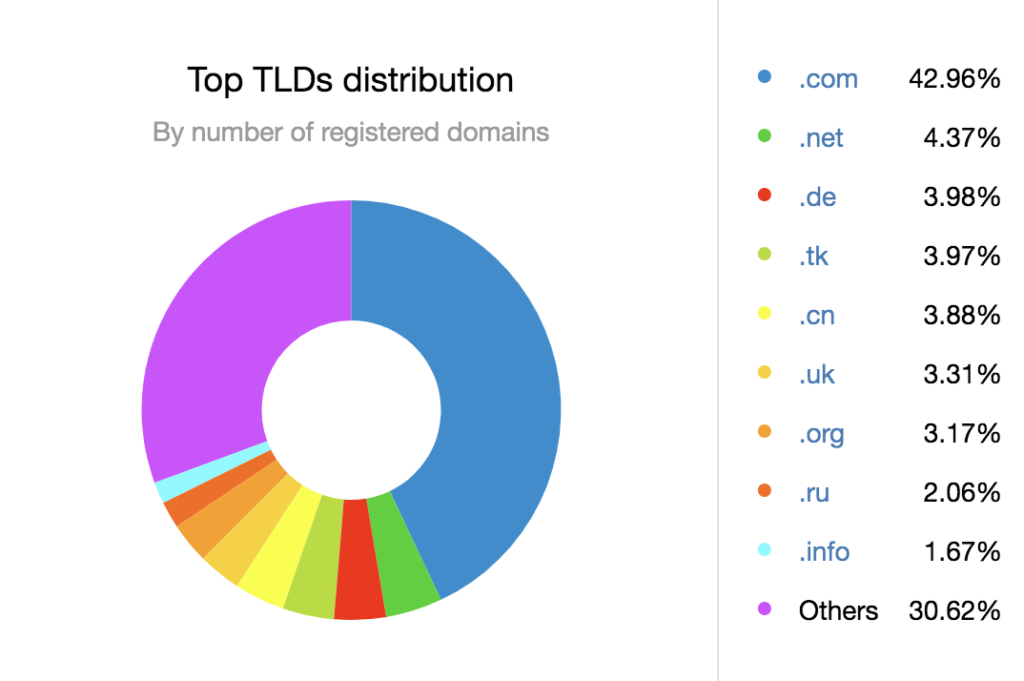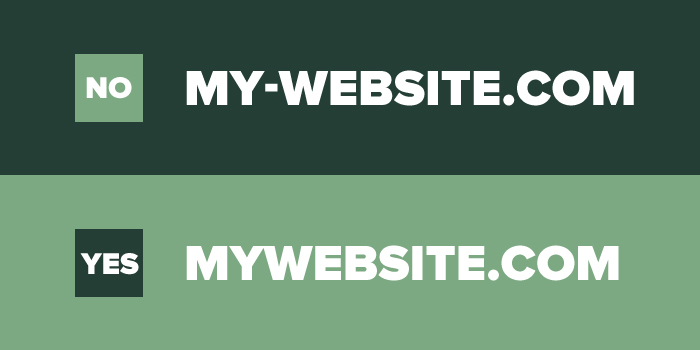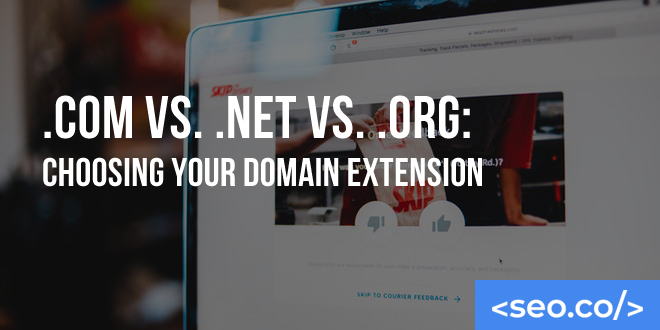When building a website for your business, you have hundreds of decisions to make. Some are small and seemingly insignificant – like what shade of blue to use for an opt-in form on an obscure blog post. Others are more important – like naming your website.
But when it comes to naming a website, all of the focus is traditionally placed on the domain name – i.e. the characters that go in between www. and .com. But in reality, there’s more to it than that. Yes, the domain name matters, but so does the new domain extension.
If you’re thinking, what the heck is a new domain extensions? Don’t worry. We’re about to cover that – and more. In today’s blog post, you’ll discover:
- What a new domain extensions is
- Why top level domain extensions matter
- Tips for choosing the best New domain extensions
By the end of reading this post, you’ll be equipped with enough knowledge of generic top level domains names extensions to build your website with direction and confidence. So roll up your sleeves and let’s get to work.
Table of Contents
What is a Domain Extensions?

To understand what top-level top-level domain or new domain extensions are and why they matter, it’s helpful to rewind back to the infancy period of the internet corporation.
If you wanted to access a website back in the 1980s, you had to type in a long string of complicated numbers (otherwise known as the website address). That was the only way early computers had of communicating across networks. It was frustrating and inefficient. The entire process was filled with friction. In order for the web to truly become worldwide for a consumer facing audience, things had to be much simpler.
It was out of this fiction that the Domain Name System (DNS) was created. Instead of typing in 216.3. 128.12 to access a website, you just type Google.com. Simple. Easy. Clean.
And along with the domain name system came domain extensions. These extensions, also known as top-level domains (TLDs), serve as a way of categorizing websites into specific groups. The original six right domain extension were .com, .org, .net, .edu, .gov, and .mil. Today, there are more than 1,000 different TLds.
Originally, there were lots of rules and restrictions on which generic domain extensions you could use. If, for example, you wanted a .org perfect domain extension, you had to prove that your organization met certain standards. These rules have become far more relaxed over the years.
Today, the most common domain extensions include:
- .com – This has always been the most popular net domain extension. It’s sort of like the gold standard. Unfortunately, it’s also the most competitive. This means it can be hard to find .com websites that are available. (There are virtually no one-word .com options available.)
- .net – Short for network, the .net extension was originally reserved for tech companies. There are currently no restrictions on who can use it, so it’s often the second choice when a .com extension isn’t available.
- .org – Originally created for nonprofits, the .org TLD is commonly used for schools, education-based websites, and other similar companies.
- .co – While relatively new to the part, the .co domain extensions has become very popular over the past year or two. (Probably because it sounds relatively similar to .com.)
There are literally hundreds of other TLDs, but you’ll probably want to start your search with one of these four. The more obscure you get, the more challenges you face (from a visibility and credibility perspective).
Why Does the Domain Extensions Matter?
Now that you know what a desired domain extension or TLD is, let’s discuss a few of the reasons why it matters:
- Sets you apart. A TLD sets your website apart from the competition. It’s a way of differentiating your company and can even be used to explain what you do. (For example, an .edu domain extensions makes it clear that your organization is involved in education.)
- Builds trust. There’s something to be said for trust and familiarity. Someone is going to feel much more comfortable visiting website.com versus website.international or website.mobi. Certain TLDs carry a reputation and you can use this familiarity to breed trust with website visitors.
- Can be trademarked. Did you know that you can actually trademark your website name? This allows you to prevent copyright issues with your business and create a strong brand that can be passed down, sold, or held for years.
- Plays a role in branding. There used to be some separation between a company’s physical presence in the real world and their online presence. Today, there are no separating lines. Thus a domain name extension and domain name directly impacts branding and marketing.
- Influences search rankings. As we’ll mention in further detail below, the TLD you select can influence your search rankings and traffic. It’s not always noticeable, but it’s certainly a factor that lies beneath the surface.
In other words, a domain extensions isn’t something you randomly select. It’s a decision that should be preceded by a certain amount of purpose and intentionality.
6 Tips for Choosing the Best Domain Extension
Being familiar with what other domain extensions are and why they matter is only the start. In order to reap the full benefits, you must select the right domain extensions for your company’s website. Here are a few tips to keep in mind:
1. Always Look for .Com First

Always, always, always go for the .com domain extensions first. It won’t always be available, but it should be the first one you try.
While other TLDs have become more popular over the years, this is still the gold standard. Research shows that roughly 51 percent of all websites use .com. This means people are more familiar with it and much more likely to trust the site. (And if someone tries to search your website manually without knowing the domain extension, they’ll automatically assume it’s .com. Using another TLD means you’ll miss out on this traffic.)
Notice we didn’t say “always use a .com” domain extension. We said always “look” for one first. If you have a generic top level domains or desirable domain name, you’ll find that it’s probably taken. This means you’ll either have to change up your domain name, or you’ll need to explore other TLD options.
2. Experiment With Other TLDs (When Appropriate)
If .com is taken, move down the list of other commonly used options. This includes .net, .org, and .co. But in addition to these recognizable domain extension, you can play around with non-traditional TLDs that fit your brand and/or website goals.
Let’s say, for example, that you’re launching an ecommerce website that sells interior design products and home goods (like wall art, curtains, hardware, lighting, etc.). If myinterordesignwebsite.com is taken, you could always try options like:
- shop
- design
That example is a bit wordy, but you get the idea. The goal is to make the name sound natural and memorable. If you can do that without using a traditional TLD, more power to you!

3. Buy Up Other Main TLDs While You Can
If you’re lucky enough to secure a .com domain names extension for your website, it’s a good idea to gobble up as many of the other main TLDs as possibly.
For example, let’s say your secure MyWebsite.com. If available, you’d also want to secure MyWebsite.org, MyWebsite.net, MyWebsite.co, etc.
Why would you do this? Well, there are two primary reasons why:
- First off, you do this to prevent other competitors from coming in and swiping these domain names. It’s sort of like staking out your land so that nobody else can claim it.
- Secondly, you can set these websites up to redirect to your main .com domain. This ensures that anyone who types in one of these web addresses will always land back at your site.
If you’re really committed to your website and you have a name that you think people might frequently misspell, you could also buy up the most common misspellings and then redirect them back to your main site.
Don’t go too crazy with this strategy. It’s unnecessary to buy 100 different versions of the same domain. But if there are a few top level options out there, you might as well.
4. Consider SEO Implications
There’s always been some debate over how much a domain name extension influences search rankings (if any). And while you’ll find people on both ends of this argument, it’s generally considered to have some effect.
As we’ve stated extensively in this post, always choose the .com name if it’s available. But if it’s taken, .net, .co, and other well-known TLDs are considered reasonable options. Low-quality TLDs, like .info, .biz, or .name will not have a positive impact on traffic (though they won’t technically have an adverse impact).
How your site eventually ranks is based on many more factors than simply your domain names. Things like meta data and semantic signals play a bigger role than they used to. No longer is it about exact match domains and exact match anchor text.
Another SEO implication is age of the domain and existing links/existing domain. If the domain has been live and has had some basic content for a couple of years it may already be out of the Google sandbox (so called), than a domain you simply pick up on Godaddy for $10.
5. Avoid Getting Too Creative

This has more to do with the actual domain name than it does with the domain name extension, but it’s worth mentioning.
It’s easy to get so caught up in the need to secure a .com website that you end up taking things too far. While it’s good if you can find a way to get a TLD, you should avoid the following:
- Adding hyphens to get the desired website. (Nobody is going to remember to type in My-Website.com. You’ll inadvertently drive traffic to MyWebsite.com, which is presumably a competitor.)
- Adding too many clarifying words. (MyWebsiteShop.com might be okay, but MyWebsiteOnlineShop.com is too wordy and confusing.)
Again, creativity is good. But too much creativity with a domain name can have adverse effects on your branding, website traffic, and search rankings.
6. Consider Making an Offer (For Taken TLDs)
Okay, let’s pose a scenario:
You have a brand new business and you’re starting a website. But you’re soon discouraged when you find that the .com domain name you want is already taken. And, if you’re being honest with yourself, there really aren’t any good alternatives. Everything that’s available is obscure and forgettable. What do you do?
Assuming you don’t have the option of renaming your business, there is a path you can take. Like any other IP or commodity, domain names can be sold and transferred. Thus it’s in your best interest to do some research on the website and see if you can buy it from the current owner. Here’s what this process looks like:
- Check the current domain. Begin the process by checking the current website. What happens when you put it into your browser bar? Does a live website show up, or does it indicate that the page is parked? And if a live site is served, does it look like it’s active, maintained, or old, or neglected? If the former, the chances of the current owner selling the website are slim. You’ll have much better luck if the website is parked or neglected.
- Find out who owns it. The next step is to find out who owns the website. There are a number of websites that let you do this, though many website owners have their information masked. You can still use a service like ICANN, though, to inquire.
- Set your budget. Set a budget before approaching the current website owner. This will minimize the confusion you feel and help you get a better feel for what a reasonable offer is.
- Make contact. The first contact is very important. You don’t want to come across as too spammy and aggressive, but you do want to make it clear that you’re an interested buyer. Rather than making an offer right off the bat, ask some questions and start a conversation. This can help you get a feel for where they stand.
- Make an offer. If you can get the current owner to set the initial price, that’s ideal. But in most cases, you’ll be asked to present your offer. Start below your budgeted number and leave room to negotiate.
- Agree to terms. After making an offer and negotiating, one of two things will happen: Either you’ll strike a deal or you’ll agree to part ways. If you strike a deal, you’ll also want to agree to additional terms (like when the transfer will happen, what will happen with the existing content on the website, rights to trademarks and other related IP, etc.). If it’s an expensive deal, you should hire a lawyer to handle the contract on your behalf.
Depending on how desirable the domain name is and how much leverage the current owner has, buying a TLD can get expensive. (The digital marketing company Sumo famously spent $1.5 million to secure Sumo.com from someone who already owned it.) That’s why it’s so important to set your budget and stick to it.
Work With SEO.co

At SEO.co, we believe in building websites with a strong foundation. This includes selecting the proper name, establishing the right structure, and filling the pages of that site with high quality content. We also understand the need for traffic – and that’s where our true passion lies.
When you work with SEO.co, we help you scale your organic traffic with the highest quality content and links. We do so by leveraging our rich network to secure authentic, white hat link placement that benefits both the publisher and your brand.
Want more information on our link building, content marketing, or public relations services? Don’t hesitate to contact us today!



